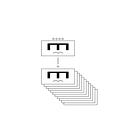This article describes the way that the historical protagonist of this decision-forcing case solved the first problem that he faced. If you have yet to read, and engage, that problem, please do so before reading the following paragraphs.
You throw two hand grenades through the hole made by the hollow charge. You then point your submachine gun into the opening and fire a burst. The crackling sound has ended and the smoke coming out of the opening is not as thick as it was before.
You shout to your men. “I’m going in. Stopp and Kupsch, follow me. The rest of you, guard the casemate.” You enter the casemate, feet first. Once inside, you move slowly into the darkness, feeling your way forward with one hand while using the other to hold the pistol grip of your submachine gun. After taking a few steps, you encounter a human being. You put the barrel of your submachine gun to his head.
The man mumbles something in a language you don’t understand. You grab his collar and drag him into the light. You see that your prisoner is a young Belgian soldier who is, as far as you can see, in a state of confusion. You yell a warning to your squad and push your prisoner through the hole in the embrasure.
Stopp and Kupsch enter the casemate. There they find two more Belgian soldiers, one of whom seems to have been hit by some of the bullets fired by your submachine gun. As Stopp and Kupsch take charge of the prisoners, you turn on your flashlight and continue to explore the casemate.
On the far end of the chamber, you see an open door, with a sliver of light and the echoes of human voices coming up from below. The diagrams and models you studied in your training lead you to believe that you have found a shaft that holds both a stairwell and an elevator leading to the underground portion of the fortress.
You throw a 3-kilogram charge down the shaft. The explosion, which is more powerful than you expected, throws you, Stopp and Kupsch against the interior walls of the casemate. When you recover your wits, you notice that the light is gone, and the voices have gone silent.
Taking the unwounded Belgian soldier with you, you descend the stairs. At the bottom of the shaft, some forty meters below the casemate, you find that the way into the fortress is blocked by a pair of steel doors. (In the fortifications that you studied in the course of the past six months, such doors were commonly reinforced with sand-bags.)
You return to the surface, where you take stock and think about what to do next. At present, you have two other missions to accomplish. One of them is to hold Objective 12. The other is to destroy Objective 10, a steel observation cupola.
This decision-forcing case ends here. However, as you might gather from the previous paragraph, a sequel is in the works. For thoughts on how these materials might be used to create a sand-table exercise, hip-pocket class, or classroom activity, please the article called Teaching Sergeant Arent.




